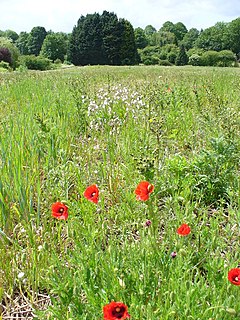Effingham, Surrey
| Effingham | |
|---|---|
 Set-aside field and woodland of the greater part of the parish, forming a green buffer from other villages within the Metropolitan Green Belt |
|
 View of the village shops on the sloped main street |
|
| Effingham shown within Surrey | |
| Area | 11.98 km2 (4.63 sq mi) |
| Population | 2,711 (Civil Parish 2011) |
| • Density | 226/km2 (590/sq mi) |
| OS grid reference | TQ1153 |
| District | |
| Shire county | |
| Region | |
| Country | England |
| Sovereign state | United Kingdom |
| Post town | Leatherhead |
| Postcode district | KT24 |
| Dialling code | 01372 |
| Police | Surrey |
| Fire | Surrey |
| Ambulance | South East Coast |
| EU Parliament | South East England |
| UK Parliament | |
Effingham is a large semi-rural and rural English village in the Borough of Guildford in Surrey, reaching from the gently sloping northern plain to the crest of the North Downs and with a medieval parish church. The village has been chosen as the home of notable figures, such as Sir Barnes Wallis who was buried here and Toni Mascolo. The M25 motorway is 4 miles (6.4 km) north-west of the middle of the village which mostly consists of green space in the Metropolitan Green Belt.
An Junction railway station is 50m north of its boundary in East Horsley, where a branch of the Sutton and Mole Valley Lines joins the New Guildford Line, which have services terminating at London Waterloo.
Long before Effingham was named by the Saxons, a prehistoric track now called the North Downs Way or Pilgrims' Way was an important prehistoric thoroughfare in Britain. Part of this ancient road forms the southern boundary of Effingham parish. It was used by early traders of flint and stone implements and there is evidence of stone age flint mining in the neighbouring village of Horsley.
A Roman coin featuring Emperor Tiberius (r. AD 14–37) and his mother Livia was found in Effingham in 1970 by Dr Sutton in land being prepared as rugby fields in King George V Playing Fields. It is not known whether the coin was dropped on the land by a passing Roman or arrived in chalk from nearby Horsley used as foundations for the rugby pitches.
In 1802 General Oliver de Lancy, Lord of the Manor of Effingham East Court, found a small camp of irregular form near Mare House, Dunley Hill in the south of Effingham parish. It is believed to be of Roman origin but was lost after the land was enclosed and became arable.
...
Wikipedia

